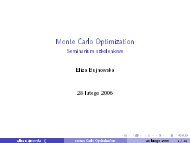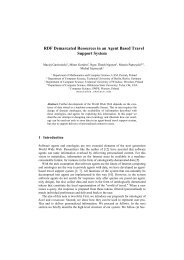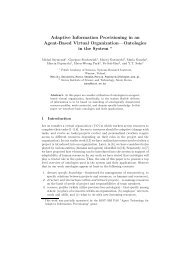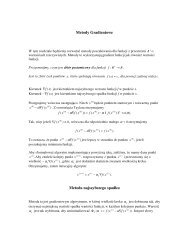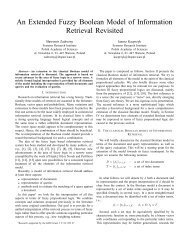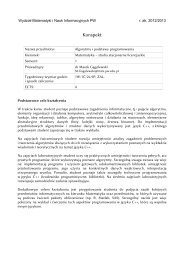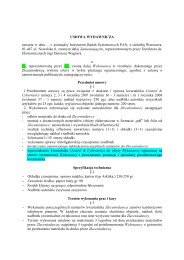Knowledge Management in an E-commerce System
Knowledge Management in an E-commerce System
Knowledge Management in an E-commerce System
You also want an ePaper? Increase the reach of your titles
YUMPU automatically turns print PDFs into web optimized ePapers that Google loves.
<strong>Knowledge</strong> <strong>M<strong>an</strong>agement</strong> <strong>in</strong> <strong>an</strong> E-<strong>commerce</strong> <strong>System</strong> 8with small circles denote po<strong>in</strong>ters to low-level knowledge <strong>in</strong> the system, while the rema<strong>in</strong><strong>in</strong>g nodes signify abstractstructures with<strong>in</strong> the ontology which clarify the relations between the po<strong>in</strong>ted-to knowledge.It must be emphasized that the variety of ontologies for structur<strong>in</strong>g knowledge <strong>in</strong> the system does not ch<strong>an</strong>ge theunderly<strong>in</strong>g knowledge itself. The characteristics of a chair do not ch<strong>an</strong>ge just because we call it someth<strong>in</strong>g other th<strong>an</strong> achair, or view it from the side or h<strong>an</strong>g<strong>in</strong>g from the ceil<strong>in</strong>g. Similarly, the knowledge that a rare commodity <strong>in</strong> greatdem<strong>an</strong>d will cost more does not ch<strong>an</strong>ge, regardless of whether it is the advertis<strong>in</strong>g eng<strong>in</strong>e or the <strong>in</strong>ventory m<strong>an</strong>agermak<strong>in</strong>g use of this knowledge. However, the feedback loop of the knowledge m<strong>an</strong>agement system does allow for thispossibility, regardless of how static the knowledge may appear to be (see discussion below).There are a huge number of possible ontologies with<strong>in</strong> the e-<strong>commerce</strong> system, some of them designed forfunctional roles (such as driv<strong>in</strong>g the user <strong>in</strong>terface) <strong>an</strong>d others def<strong>in</strong>ed to provide a high-level overview of the system.These latter ontologies/perspectives are of particular <strong>in</strong>terest to us as researchers, as they allow us to observe <strong>an</strong>dm<strong>an</strong>ipulate the knowledge <strong>in</strong> the system, keep<strong>in</strong>g <strong>in</strong> m<strong>in</strong>d that even at the greatest level of abstraction these perspectivesstill refer to the low-level knowledge ga<strong>in</strong>ed from experts, user <strong>in</strong>teractions, etc., <strong>an</strong>d c<strong>an</strong>, if necessary, be concretized toknowledge actually represented <strong>in</strong> the knowledge base.F<strong>in</strong>ally, let us address the question of meta-knowledge. Its st<strong>an</strong>dard def<strong>in</strong>ition is “knowledge about knowledge.”Observe first, that ontologies c<strong>an</strong> already be considered examples of meta-knowledge, because they org<strong>an</strong>ize knowledge<strong>an</strong>d thus represent knowledge about knowledge. S<strong>in</strong>ce ontologies c<strong>an</strong> conta<strong>in</strong> ontologies, we are deal<strong>in</strong>g with ahierarchical structure, where each higher level represents a reflection about knowledge occurr<strong>in</strong>g on lover levels. In thisway our system does not support a st<strong>an</strong>dard division of knowledge <strong>in</strong>to knowledge <strong>an</strong>d meta-knowledge, but rather arelational web of knowledge that represents the system’s view of the reality it is immersed <strong>in</strong>.5. KNOWLEDGE STRUCTURE: PERSPECTIVESSo far we have <strong>in</strong>troduced the sources <strong>an</strong>d techniques of acquisition of low-level knowledge. We have also discussed theidea of apply<strong>in</strong>g ontologies to impose useful relations on the build<strong>in</strong>g blocks of low-level knowledge <strong>an</strong>d argued thatthere are multiple perspectives/ontologies on knowledge that will co-exist <strong>in</strong> the system. Let us now look at some of themore import<strong>an</strong>t of these perspectives, divided <strong>in</strong>to two categories: five that are most relev<strong>an</strong>t to hum<strong>an</strong> <strong>an</strong>alysts, <strong>an</strong>d threethat are particularly useful for implementation of the system.5.1 Empirical-model-situation knowledge structureThis ontology considers three types of knowledge with<strong>in</strong> the system: empirical knowledge, model knowledge <strong>an</strong>dsituational knowledge. It is based on how knowledge is applied by hum<strong>an</strong>s <strong>in</strong> ord<strong>in</strong>ary situations. As hum<strong>an</strong>s we possessempirical knowledge (such as the natural laws, <strong>an</strong>d also what is referred to as “common sense” but is not all thatcommon), which is the foundation of our models for view<strong>in</strong>g the world. These models, <strong>in</strong> order to be applicable toeveryday situations, must be concretized by the details of the situations. The same approach to underst<strong>an</strong>d<strong>in</strong>g theutilization of knowledge with<strong>in</strong> the e-<strong>commerce</strong> system, while heavily abstracted from the actual implementation of thesystem, allows us to underst<strong>an</strong>d the knowledge m<strong>an</strong>agement processes from a hum<strong>an</strong> perspective, <strong>an</strong>d <strong>in</strong> m<strong>an</strong>y situationscompare <strong>an</strong>d adapt the actions <strong>an</strong>d reactions of hum<strong>an</strong> commercial org<strong>an</strong>izations to that of e-<strong>commerce</strong> systems. Let usconsider each level of knowledge approached from this perspective <strong>in</strong> some detail.5.1.1 Empirical knowledgeEmpirical knowledge of the world is the most general <strong>an</strong>d most fundamental type of knowledge, <strong>an</strong>d it rema<strong>in</strong>s relativelyconst<strong>an</strong>t throughout ch<strong>an</strong>g<strong>in</strong>g models <strong>an</strong>d situations. At the core of this knowledge are the statements, pr<strong>in</strong>ciples <strong>an</strong>drules describ<strong>in</strong>g economic phenomena, which are central to the operation of <strong>an</strong>y market player. Of course, this knowledgeis available to all players, though it is rarely stated explicitly but is mostly present <strong>in</strong> the common cultural knowledge ofhum<strong>an</strong> org<strong>an</strong>izations. Examples of empirical knowledge <strong>in</strong>clude the laws of supply <strong>an</strong>d dem<strong>an</strong>d, price curves, basicmarket models <strong>an</strong>d strategies, etc. These rules are much too general to build competitive sales strategies, negotiate priceswith suppliers, or otherwise ref<strong>in</strong>e the system, but merely allow the system to operate <strong>in</strong> the marketplace.International Conference on Electronic Commerce Research (ICECR-5)



